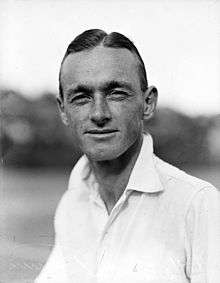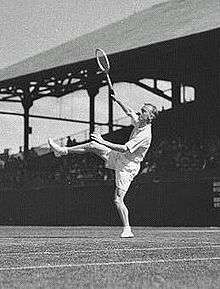Harry Hopman
Henry Christian "Harry" Hopman, CBE (12 August 1906 – 27 December 1985) was a world-acclaimed Australian tennis player and coach.
 | |
| Full name | Henry Christian Hopman |
|---|---|
| Country (sports) | |
| Born | 12 August 1906 Glebe, New South Wales |
| Died | 27 December 1985 (aged 79) Seminole, Florida, USA |
| Height | 1.70 m (5 ft 7 in) |
| Plays | Right-handed (one-handed backhand) |
| Int. Tennis HoF | 1978 (member page) |
| Singles | |
| Career record | 463-201 (69.7%) [1] |
| Career titles | 34 [2] |
| Grand Slam Singles results | |
| Australian Open | F (1930, 1931, 1932) |
| French Open | QF (1930) |
| Wimbledon | 4R (1934, 1935) |
| US Open | QF (1938, 1939) |
| Doubles | |
| Career record | 0–0 |
| Grand Slam Doubles results | |
| Australian Open | W (1929, 1930) |
| French Open | F (1930, 1948) |
| US Open | F (1939) |
| Grand Slam Mixed Doubles results | |
| Australian Open | W (1930, 1936, 1937, 1939) |
| Wimbledon | F (1945) |
| US Open | W (1939) |
Hopman was born in Glebe, Sydney, New South Wales, before his family moved to Parramatta, a city adjoining Sydney and now effectively a suburb of the metropolis.
Hopman was a student at Rosehill Public Primary (elementary) school, where his father was headmaster, and later at Parramatta High School, where he played tennis and cricket.
Early life
Harry Hopman was born on 12 August 1906 in Glebe, Sydney as the third child of John Henry Hopman, schoolteacher, and Jennie Siberteen, née Glad. He started playing tennis at the age of 13 and, playing barefoot, won an open singles tournament on a court in the playground of Rosehill Public School, where his father was headmaster.[3]
Davis Cup
.jpeg)
Hopman was the successful captain-coach of 22 Australian Davis Cup teams from 1939 to 1967. With players such as Frank Sedgman, Ken McGregor, Lew Hoad, Ken Rosewall, Rod Laver, Neale Fraser, John Newcombe, Fred Stolle, Tony Roche, Roy Emerson, Ashley Cooper, Rex Hartwig, Mervyn Rose, and Mal Anderson, he won the cup an unmatched 16 times.
In late 1951, when it appeared that Davis Cup player Frank Sedgman was about to turn professional, Hopman used his column in the Melbourne Herald to lead a fundraising campaign designed to keep Sedgman in the amateur ranks. Enough money was raised to purchase a gasoline station in the name of Sedgman's wife-to-be and Sedgman remained an amateur for one more year. As Joe McCauley writes in The History of Professional Tennis, "For some reason, the pious Hopman, a strong opponent of the paid game, did not regard this as an infringement of Sedgman's amateur status."[4]
Journalism

Hopman was also a journalist, joining the Melbourne Herald in 1933 as a sportswriter. He provided sporting commentary. After World War II, this became his focus until he was once again coaxed into tennis coaching. As an example of Hopman's journalism, Kramer writes that Sedgman, by then a successful touring professional, once "volunteered to help train the Aussie Davis Cup team. Hopman accepted the offer, and then he took Sedg aside and told him that what Hoad and Rosewall needed was confidence. So he told Sedg to go easy on them, which he gladly did. After a few days, Hopman wrote an exclusive in his newspaper column revealing how his kids could whip Sedgman and how this proved once again that amateurs were better than the pros."[5]
Legacy
The Hopman Cup is named in his honour. His widow, Lucy Hopman, travels to Perth, Western Australia in January each year for the tournament.
Hopman was inducted into the International Tennis Hall of Fame in Newport, Rhode Island in 1978.
Tennis great Jack Kramer, who was also a successful promoter of the professional tour, writes in his 1979 autobiography that Hopman "always knew exactly what was going on with all his amateurs. He had no children, no hobbies, and tennis was everything to him. Hopman always said he hated the pros, and he battled open tennis to the bitter end, but as early as the time when Sedgman and McGregor signed, Hopman was trying to get himself included in the deal so he could get a job with pro tennis in America."[5]
Kramer, who admits that Hopman "has never been my favorite guy", goes on to say: "The minute one of his stars would turn pro, Hopman would turn on him. No matter how close he'd been to a player, as soon as he was out of Hopman's control, the guy was an outcast. 'It was as if we'd never existed' Rosewall said once."[5]
Personal life
Hopman was first married to Nell Hall, with whom he won four mixed doubles finals. The marriage took place on 19 March 1934 at St Philip's Anglican Church in Sydney. She died of an intracranial tumour on 10 January 1968.[6] Hopman emigrated to the United States in 1969 and became a successful professional coach, at Port Washington Tennis Academy, of future champions such as Vitas Gerulaitis and later John McEnroe. Hopman later opened the Harry Hopman's International Tennis camp in Treasure Island then Largo, Florida, with his second wife, Lucy Pope Fox, whom he married on 2 February 1971.[7]
Hopman died of a heart attack on 27 December 1985.[8]
Tournament record
Australia Davis Cup
Player
- 1928, 1930, 1932
Captain
- 1938–1939, 1950–1969
- Winner: 1939, 1950–1953, 1955–1957, 1959–1962, 1964–1967
- Runner-up: 1938, 1954, 1958, 1963, 1968
Italian Championship
- Mixed Doubles 1934
Grand Slam finals
Singles: 3 (3 runner-ups)
| Outcome | Year | Championship | Surface | Opponent | Score |
|---|---|---|---|---|---|
| Runner-up | 1930 | Australian Championships | Grass | 3–6, 1–6, 3–6 | |
| Runner-up | 1931 | Australian Championships | Grass | 4–6, 2–6, 6–2, 1–6 | |
| Runner-up | 1932 | Australian Championships | Grass | 4–6, 6–3, 3–6, 6–3, 6–1 |
Doubles: 7 (2 titles, 5 runner-ups)
| Outcome | Year | Championship | Surface | Partner | Opponents | Score |
|---|---|---|---|---|---|---|
| Winner | 1929 | Australian Championships | Grass | 6–1, 6–8, 4–6, 6–1, 6–3 | ||
| Winner | 1930 | Australian Championships | Grass | 8–6, 6–1, 2–6, 6–3 | ||
| Runner-up | 1930 | French Championships | Clay | 3–6, 7–8, 3–6 | ||
| Runner-up | 1931 | Australian Championships | Grass | 2–6, 4–6, 3–6 | ||
| Runner-up | 1932 | Australian Championships | Grass | 10–12, 3–6, 6–4, 4–6 | ||
| Runner-up | 1939 | US Championships | Grass | 6–8, 1–6, 4–6 | ||
| Runner-up | 1948 | French Championships | Clay | 6–8, 1–6, 10–12 |
Mixed doubles: 8 (5 titles, 3 runner-upa)
| Outcome | Year | Championship | Surface | Partner | Opponents | Score |
|---|---|---|---|---|---|---|
| Winner | 1930 | Australian Championships | Grass | 11–9, 3–6, 6–3 | ||
| Runner-up | 1932 | Wimbledon Championships | Grass | 5–7, 2–6 | ||
| Runner-up | 1935 | Wimbledon Championships | Grass | 5–7, 6–4, 2–6 | ||
| Winner | 1936 | Australian Championships | Grass | 6–2, 6–0 | ||
| Winner | 1937 | Australian Championships | Grass | 3–6, 6–3, 6–2 | ||
| Winner | 1939 | Australian Championships | Grass | 6–8, 6–2, 6–3 | ||
| Winner | 1939 | US Championships | Grass | 9–7, 6–1 | ||
| Runner-up | 1940 | Australian Championships | Grass | 5–7, 6–2, 4–6 |
References
- Garcia, Gabriel. "Harry Hopman: Career match record". thetennisbase.com. Tennismem SL. Retrieved 7 November 2017.
- Garcia, Gabriel. "Harry Hopman: Career match record". thetennisbase.com. Tennismem SL. Retrieved 7 November 2017.
- "Hopman, Henry Christian (Harry) (1906–1985)". Australian Dictionary of Biography.
- The History of Professional Tennis (2003) Joe McCauley, p. 58.
- Jack Kramer with Frank Deford (1981). The Game : My 40 Years in Tennis. London: Deutsch. pp. 224, 225. ISBN 0233973079.
- "Hopman, Eleanor Mary (Nell) (1909–1968)". Australian Dictionary of Biography.
- Marilyn Brown (3 February 1976). "Tennis, Anyone?". The Evening Independent. p. 16A.
- "Harry Hopman, Davis Cup captain, dies". The Evening Independent. 30 December 1985. p. 1C.
Sources
- The Game, My 40 Years in Tennis (1979), Jack Kramer with Frank Deford (ISBN 0-399-12336-9)
- The History of Professional Tennis (2003), Joe McCauley
- Rich Hillway, tennis historian
Further reading
- Hopman, Harry (1972). Better tennis for boys and girls. New York: Dodd, Mead. ISBN 0-396-06365-9.
External links
| Wikimedia Commons has media related to Harry Hopman. |